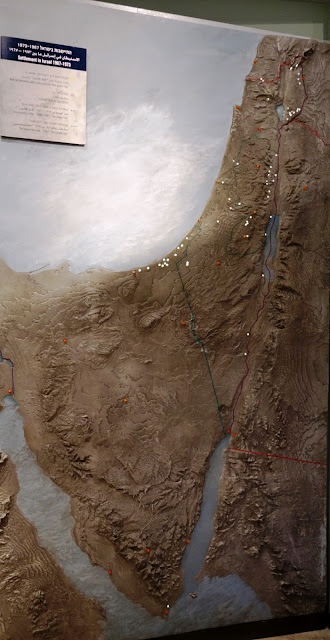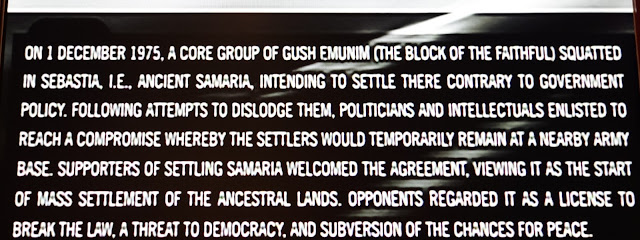On March 29, after my visit at Achva College, I bravely drove to Tel Aviv, exiting near the north end of town and found the Rabin Center where I met up with Amalia and her friend Gila who was able to get tickets for us to the Rabin Center and to the special exhibit on Entebbe, marking the 40th anniversary of the rescue in the Ugandan airport of the passengers of an Air France flight.
In the entry while waiting for Amalia, I saw the life line of Rabin.
There is no real gift shop at the center, but several books and memorabilia are by the ticket office that are for sale.
Then the rest of the museum chronicles the life of Rabin from 1922 to his death in 1995. His life in on the walls and his positions/jobs were on the floor of the main, circular hallway (including artifacts from his life), with rooms off to the side that tell of events in Israel at that time. Once I got the hang of it, I really like the way that Rabin's personal and public lives were balanced with what was happening in the world, and what was happening in more detail in Israel in the rooms off of the main corridor.
 |
| An example of what the main hall looks like. The blue area is and overlook to the floor below. |
The long explanation on each wall marked a period of Rabin's life. The first was his youth from 1922--1937. He was a sabra--born in Jerusalem in 1922 and raised in Tel Aviv. Signs are in Hebrew, Arabic,and English.
 |
| Rabin's youth--the bottom shows some school reports and books |
 |
| Sailing on the Kinneret
The next period was 1941 to 1947 when Yigal Allon recruited Rabin to the Palmach.
|
 |
| Gila shows what is happening in Israel-- in the inner room--Road to Independence |
 |
| Tel Aviv develops as a city |
 |
| A new port in Tel Aviv |
Below, Amalia looks down at what is happening in the world at this time and to the right is the establishing of kibbutzim in the Negev overnight--putting up a water tower and one building so as to be in compliance with (Turkish?) laws to be able to stay on the land. The land was owned by the Jews but the British were not allowing them to build settlements. In the center background you can see the rust colored "dilemma" signs.
Happening in the World: the movie "Gone with the Wind," British develop radar, Penicillin discovered, Hitler elected in Germany, First Transatlantic Phone call.
Below: Example of a dilemma:
How to Partition Palestine--the Peel Commission Plan in 1937, in which the Negev would not be part of Israel. The Jews accepted the plan but the Arabs did not.
Meanwhile Hitler was coming up with his plan to annihilate the Jews
 |
| Rabin's roles from 1945 through 1948 |
Meanwhile, there were clashes between Jewish military groups. The Altalena, a ship acquired by the Etzel in Europe to transport arms, new immigrants and volunteers, arrived in Israel during the Independence war. Negotiations over unloading the arms and their transfer to the newly established Israel Defense Forced ended in armed clashes. During the battle to control the ship, 16 members of Etzel (Irgun) and 3 IDF soldiers were killed, and several hundred were arrested. The incident caused great controversy and left a hard feeling between Jew and Jew.
The UN voted to created the States of Israel and Palestine in November, 1947. Because of the secret establishment of 11 kibbutzim in the Negev on Yom Kippur night, 1946 and their quick and beautiful development, the Negev was given to the future state of Israel by the fledgling UN.
Egypt especially wanted the Negev to have a clear path to the other Arab countries, Jordan, etc. Attacks against Jews increased after the vote.
 |
| Declaration of the State of Israel in the UN. |
 |
| Focus on the Hof Ashkelon area just above and onthe right of Gaza |
Rabin was an avid photographer and look at the wonderful camera he had. He also had a beautiful handwriting--like an Israeli high school student.
From 1948-49, there was a huge fight with Egypt for control of the Negev. As operations chief for the southern front, Rabin was involved in planning the major campaigns to crush the Egyptian army. He also took part in the armistice talks in Rhodes. Rabin was upset when then Prime Minister and Defense Minister Ben Gurion disbanded the Palmach, but Rabin decided to stay in the military in spite of that decision, a decision that would determine the course of the rest of his life.
From 1950 to 1963, Rabin was a career army officer. Here is a special photo with him and other future leaders:
From 1949 to 1967 was the era of "state-building," the in-gathering of exiles--Holocaust survivors and Jews from North Africa and other Middle East countries where they were no longer welcome after the creation of the state of Israel.
By 1952, Israelis population had doubled. Although much was put into providing housing, jobs, education and food for the new immigrants, it was not enough, so many were in makeshift transit camps and because of the diverse group of immigrants, language problems and cultural differences, the absorption ministry was overwhelmed.
Meanwhile, the armistice agreements were not peace treaties, and the Arab states said that there were could a "second round" with Israel. The borders were not sealed; both Arab refugees and terrorists infiltrated Israeli territory. In the mid-1950s, Egypt established Fedayeen (terrorist) units in Gaza, attaching surrounding Israeli communities.
Israel had reprisal attacks, but they did not lead to calm.
In June, 1956, Nasser of Egypt nationalized the Suez Canal. Israel joined forces with England and France form Oct. to Nov. of 1956 on the Sinai Campaign, where Israel conquered the Sinai Peninsula and the two European armies try to capture the Canal area. But the USSR and US led strong international pressure for Israel to withdraw from the Sinai, which Israel finished by March of 1957.
Egypt agreed for Israeli vessels to pass through the canal and a UN emergency force served as a buffer between Israeli and Egyptian forces and the bordered remained quiet for ten years.
While the country operated on a socialist base, North African immigrants felt discrimination. In 1959, Wadi Salib in Haifa was substandard housing for new immigrants, mostly from North Africa. Following a violent incident between a local and the police, residents organized demonstrations aimed at the police, the MAPAI ruling party, and Histadrut workers organization, protesting against discrimination and neglect. Th demonstrations spread to other cities, which were heavy-handedly dispersed by police and sharply condemned by the government. The Wadi Salib riots still resonate in Israeli society as a symptom of social problems in that early era of the state that led to clashes between Mizrachi and Ashkenazi Jews.
During the Independence Day parade on May 15, 1967, reports came that Egypt was moving troops into the Sinai. The Arab media proclaimed Israel's imminent destruction, and Syria and Jordan supported Egypt, who again blocked the Straits of Tiran. The Israeli army was confident of its strengh, but civilians feared for their survival. The creation of a national unity government and appointment of Moshe Dayan as Defense Minister raised morale. When diplomatic efforts to settle the conflict failed, Israel went to war.
 |
| Rabin, always with his men. |
After Israel's huge victory in 1967, it became a regional power. There was hope of some sort of negotiation with the Arab states, but no such thing resulted and a war of attrition occurred near Suez, Jordan and Lebanon. Meanwhile, the Israeli government promoted settlements on the Golan Hights, in Sinai, and the Jordan Valley, strategically important areas that were virtually uninhabited. It did not permit Jewish settlement in densely-populated Arab areas. Nevertheless, the Etzion Bloc settlements, destroyed in 1948, were rebuilt as a mark of respect for their heroic past.
 |
| Spots mark settlements in new areas acquired in 6-Day War one dot on the Golan includes where I lived--Merom Golan |
At 2 p.m., on Yom Kippur, October 6, 1973 Arab countries attacked Israel. The country was caught by surprise as it seemed to be a low priority. I was on kibbutz with my 4-month-old daughter. Buses were to arrive at 1 p.m. to evacuate women and children but as typical, the buses arrived one hour late, just as the war began. We rushed into shelters and were only evacuated after dark at 6 p.m. where there was a lull.
 |
| Attack on the Golan from Syria |
After days of fierce fighting, the capture of the Suez Canal marked a turnabout in the fighting. Our kibbutz members were not called up as we lived on the border, but 12 volunteered and four died in the fighting, including my husband's boss, Avremeleh. Our older son Avi is in part named for him.
The IDF won, but Israel mourned the loss of 2,569 dead, and left the country in shock. The heavy setbacks and huge loss of life were seen as military lack of preparedness. A commission absolved the political leadership but faulted the military command. Protests sprang up demanding the resignation of Defense Minister Dayan and Prime Minister Golda Meir. The cabinet resigned, and Rabin headed the next government.
Elections were held in 1977, and for the first time, the Labor party was not the leading party to get votes, and Menachem Begin became the prime minister.
 |
| 1979, peace with Egypt
Below: pictures from family albums:
|
 |
In 1991, the USSR collapsed, and immigration to Israel from that area increased greatly.
After winning the elections in 1992, Rabin became Prime Minister and Defense Minister again. He changed national priorities by cutting the settlement budget and increasing the budgets for education, welfare, and infrastructure, the Arab sector and the communities outside the big three cities. Resources were allocated for absorbing the mass of immigrants from the former Soviet Union and for creating jobs.
Bookshelves in his study.
And a fitting poem at the end of the center:
There was also an amazing temporary exhibit of the Entebbe Rescue, 40 years ago this year. If you are interested in learning more about it, let me know.
 |
| View of Tel Aviv from an open area at the Rabin Center. |


































No comments:
Post a Comment